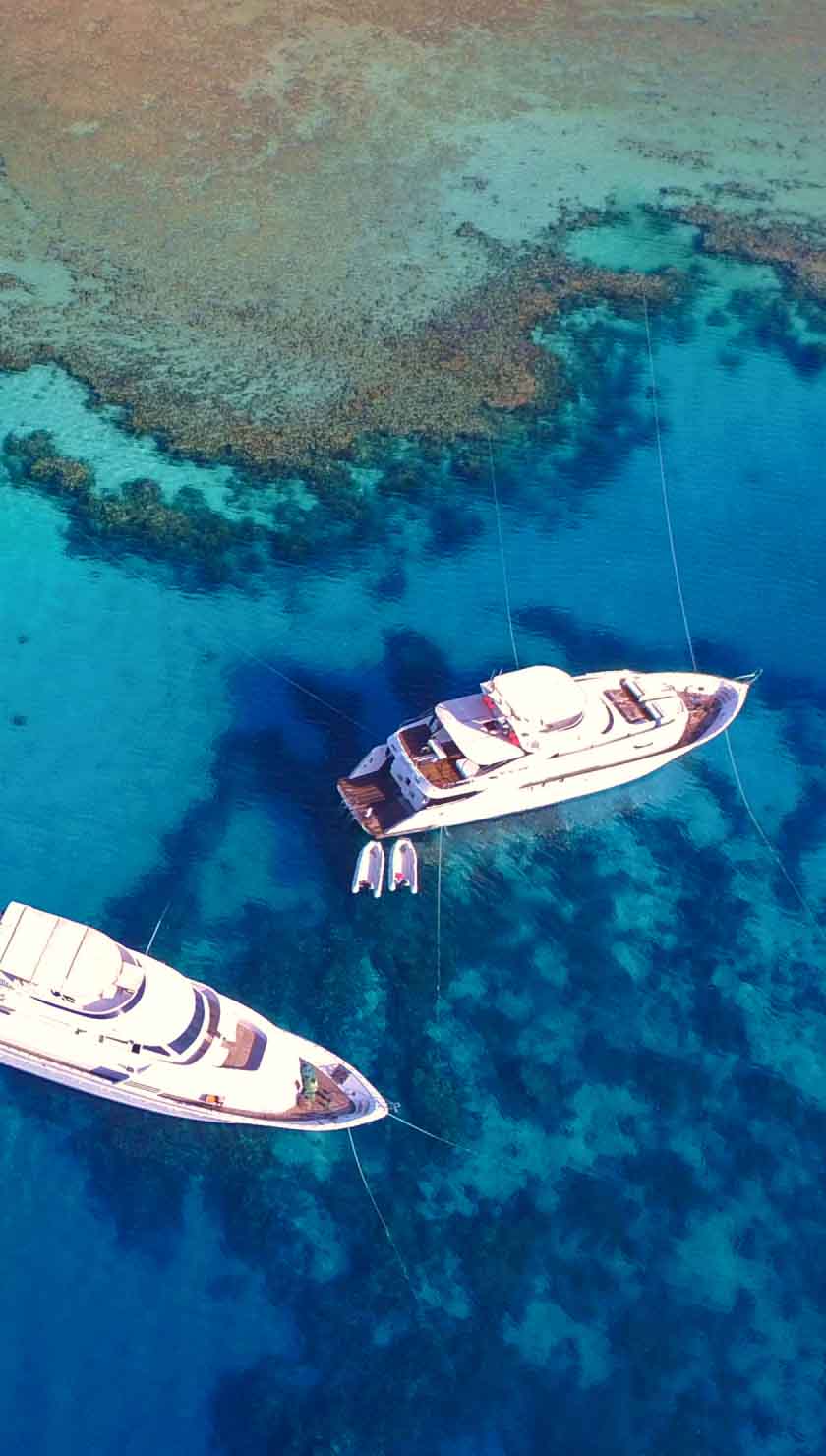Liveaboard Diving in Baa Atoll
Baa Atoll Liveaboard dive sites
Baa Atoll in the north of the Maldives is known for having loads and loads of fish, a great variety of species, fun topography (especially overhangs), awesome manta-viewing, and not a lot of liveaboards crowding the scene. Baa's relative solitude compared with Male and its neighbors can heighten one's enjoyment of the treasures waiting underwater.
Hard coral quality varies in Baa Atoll, but at the dive site Maavaru Kandu, you won't miss it when you witness the enormous carpets of swaying soft corals that cover every square inch of the rocky surface with a glow of blue, yellow, orange and green. You can view these soft corals all around (and even above) you from within enormous overhangs whose ceilings are just as decorated as the floor. The visuals at Maavaru Kandu are unlike anywhere else in the Maldives. Fish life, black corals, hard corals, and whip corals complete the scene.
Dhonfanu Thila lacks Maavaru Kandu's soft corals, but in every other respect, it offers the best in Baa Atoll liveaboard diving. First of all, it's brimming with fish. Soldierfish and snappers lurk in overhangs, fusiliers shimmer in the blue water, and tons of other reef species make sure there's always movement enlivening the scene. Dhonfanu Thila also sports Baa's typical interactive topography of overhangs and swim-throughs. To top it off, it's got mantas. Dhonfaru Thila is the best northern atoll dive site to see these iconic creatures.
Dhigali Haa is famous for mantas and hosts great fish biomass. While schools of tiny silvery fish and jacks dance out their predator-prey drama along the sides of the pinnacle, slower-moving reef fish stand sentinel in the sheltered areas, and colorful reef-flat inhabitants play in the pinnacle's shallows. Whip corals, bushy black corals, and other photogenic benthic life give additional diversity to the site.
Baa Atoll might be most famous for Hanifaru Bay. This area does not even allow diving, but Baa Atoll liveaboards will be sure to visit it from May through December for an incomparable sight: huge aggregations of both manta rays and whale sharks going wild in a plankton-eating frenzy that is perhaps more high-energy than anywhere else in the world. As a World Biosphere Reserve, Hanifaru Bay is an unparalleled draw for marine life enthusiasts, professional photographers, and researchers. Only sixty people are allowed in the bay at one time to see the rollicking, rolling behavior that the bay's abundance of food brings out in these normally sedate giants of the sea.
The northern atolls can be a bit of a downer for shark-lovers, except for Noonu Atoll. At a dive site called Orimas Thila, there is a channel where grey reef sharks swarm in numbers of twenty or higher. Expect your dive guide to bring you to a resting point just down-current, where you can kneel comfortably without disturbing the inhabitants. This dive site is ideal for checking out a whole community of sharks doing their thing, from small juveniles to adults over three meters long.
Noonu Atoll's Christmas Tree Rock is also worth a visit. The topography here consists of large shelves of life-encrusted rock divers can peer under and swim through to search for big and small reef inhabitants. Adding to the Christmas tree imagery, small dancing fish of vibrant pink, yellow, and blue ornament the different levels of the ìtreeî with their bright colors. Reef sharks and rays rest in the dark, and large pelagics like tuna stream through the blue water off the sides. With a hard coral garden at the top, divers often cite Christmas Tree Rock as one of their favorite northern atoll dive sites.
At Lhaviyani Atoll, the dive site Madivaru hosts abundant fish life, from butterflyfish to Napoleon wrasse, in the crevices and overhangs of its vertical wall. Triggers, tuna, and barracuda add to the action in the adjacent blue water. Divers should also note that the channels of Lhaviyani Atoll are another great place to see tons of sharks in the northern atolls. Raa Atoll, with its dive sites Fenfushi Giri and Reethi Thila, also holds immense fish variety and volume, from Napoleon wrasse to tuna, and Reethi Thila is good for a bit of macro as well. Remote Haa Alifu and Haa Dhalu Atolls represent the northernmost extent of Baa Atoll liveaboards and the northernmost point of the entire country.
Itinerary details
The length of most liveaboard itineraries in Baa Atoll ranges from 7 to 10 nights, with budgets from 200 to 400 euros per night. Many itineraries on a Baa Atoll-bound liveaboard include North Male and Ari Atoll. Some even venture as far south as Vaavu and Meemu. Other itineraries may spend all their time in the north, hopping between Baa's uncrowded neighbors, Lhaviyani, Noonu, and Raa. Still, other liveaboards venture even farther north to Haa Alifu or Haa Dhalu Atolls, the northernmost area of the Maldives. Liveaboards in Baa Atoll are mostly MV yachts and luxury yachts.
The experience level required by Baa Atoll liveaboards can be 30, 50, or 100 logged dives, with a certification level of Open Water for some boats and Advanced Open Water for others. The moderate currents mean diving within the atoll (instead of along the edge) suits beginners. However, all Baa Atoll liveaboards visit a variety of Maldives atolls so that the diving can range in difficulty depending on the destination.
Liveaboard departures
Many liveaboards bound for Baa Atoll depart from Male. However, some depart from Hanimadhoo on Haa Dhalu or from Baa (also called Dharavandhoo). Baa and Hanimadhoo can be reached by domestic seaplane from Male. Direct flights from Dubai, Singapore, and Colombo easily reach Male. Longer international flights from Europe, America, China, India, and Australia are readily available, often connecting through the airports mentioned above.
Best time to travel
Baa Atoll dive sites can be visited year-round, though the southwest monsoon from May to November can make the seas choppy; December to April is the season with the best conditions. However, the mantas and whale sharks are most plentiful from August to November, so consider a trip during that time of year if the giants are your number one priority. In Baa Atoll, the water temperature stays stable at 27-30 C and visibility at 10-30 meters.











